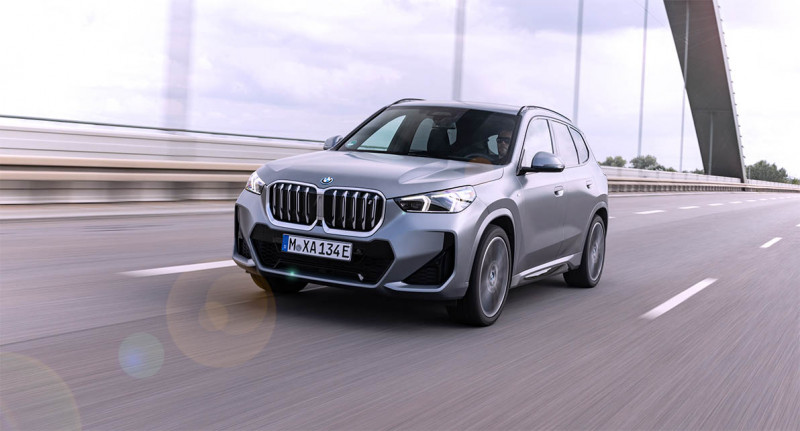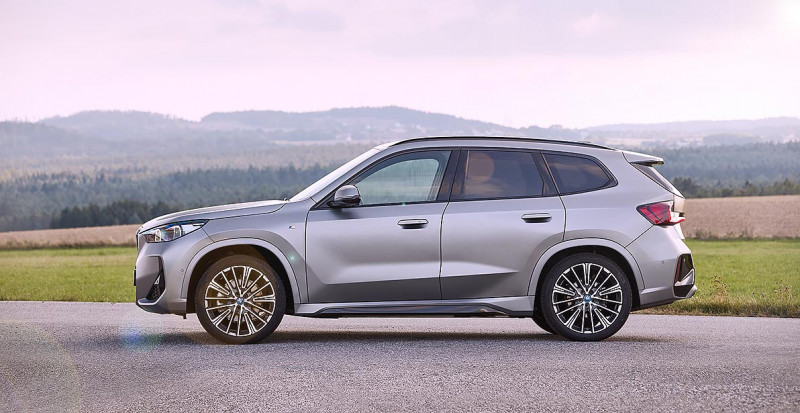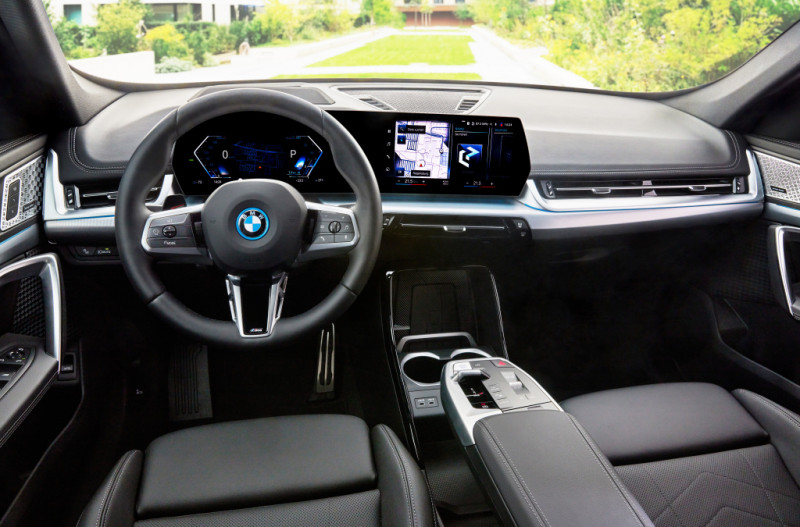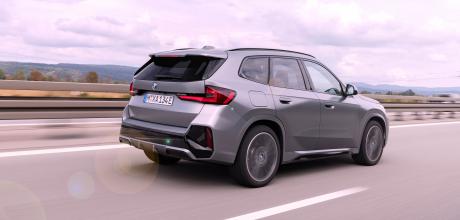2024 BMW iX1 xDrive30 M Sport U11 vs. 2024 X1 xDrive23i M Sport U11
The X1 is a crucial part of the BMW range, and the new model – with its choice of petrol, diesel, hybrid and electric power – is the best yet.
First Drive: BMW U11 X1
We sample the latest X1 tosee if it’s third time lucky forthe entry-level X model.
Words: James Fossdyke
Photos: Uwe Fischer
For BMW enthusiasts, the humble X1 is not necessarily the most desirable product in the BMW range. The smallest of the SUVs, it isn’t usually considered fast, fancy or fun enough to get the pulses racing, but the X1’s importance to BMW is not to be underestimated. The first-generation X1, codenamed E84, was launched in 2009, and between that and the introduction of the second-generation F48, a total of 2.7 million units have been sold.

As a result, the new X1, which is codenamed U11, has quite a job to do. In fact, it’s one of the key pillars propping up halo products such as the forthcoming 3.0 CSL E9 and other M cars. And while those cars steal away all the glamour, it’s the poor old X1 that has to do the heavy lifting. To help it out, BMW has completely redeveloped it to the point where almost nothing has been carried over from the old car. Under the skin, the U11 sits on the same “UKL2” platform as the 1 Series and 2 Series Gran Coup., which means it also shares underpinnings with the 2 Series Active Tourer – something that becomes blindingly obvious when you see the new, more upright grille.

Whatever your opinions on the front end, though, the new X1 is quite a handsome thing. The grille isn’t that much bigger than before, and the overall proportions have somehow improved. The E84 always looked a bit too small for its styling, and while the F48 was an improvement, the U11 is altogether more appealing.

It’s more attractive inside, too, where BMW has simply taken the 2 Series Active Tourer’s cabin and shoehorned it into the X1. That means you get the same “Curved Display” infotainment system, which houses the touchscreen and the digital instrument cluster in one enormous panel, and you get the floating centre console that houses the drive selector and some media controls. Other than that, though, the dashboard is more or less devoid of switchgear, and that’s a mixed blessing.
On the one hand, that has allowed the designers to have their way with the dash, fitting a huge wireless charging dock that would take a small tablet rather than just a conventionally sized smartphone, and leaving the rest looking clean and modern. On the other hand, that means even the climate control system has been tucked away in the touchscreen, and that’s usually an ergonomic nightmare.
However, because the X1 uses the same touchscreen as the 2 Series Active Tourer, the iX electric SUV and even the updated 3 Series, the system isn’t all that bad. The temperature settings are always displayed on a little taskbar at the bottom of the screen, for example, and that means it’s relatively easy to access and alter. Doing more complex tasks, though, requires a few more taps of the screen, and that means your attention is drawn from the road for longer. Had the iDrive controller been fitted, as it is even on the latest-generation 3 Series, the system would be a little more user-friendly.
But even without that, it’s far from the worst touchscreen system on the market. The display is clear and crisp, and the screen responds quickly to any inputs. The voice control system still needs a little work, but that’s true of any system on the market. And the digital instrument cluster that sits alongside the touchscreen is much better than anything we’ve seen in any last-gen BMWs. It’s clear and configurable and much easier to use than some of the old displays fitted to the pre-facelift 3 and 4 Series when they first came out.
As well as bringing in fresh technology, the new X1’s cabin also adds some fresh practicality. The front seats feel light and airy thanks to the low centre console and the simple dashboard, while seat adjustment is ample and headroom is plentiful, as is shoulder space. In the rear, there’s more than enough space to seat two six-foot adults, so there’s no need to worry about whether children will be happy back there – and the central transmission tunnel isn’t all that intrusive.
Luggage space is ample, too, although how much you can get in does depend on which version of the X1 you choose. Basic models get 540 litres of carrying capacity, which almost puts them on par with the larger X3. However, choosing different engine options can cut that down to as low as 490 litres. Even with that 50-litre reduction, though, it’s still a spacious family car.
As well as providing more space, the real upside to the shared platform is the ability to give the X1 pretty much any powertrain BMW likes. So, as well as the conventional petrol and diesel options, BMW will also offer customers plug-in hybrid and electric power, with the latter model wearing the new iX1 badge. As a result, the engine range is naturally very broad indeed, with no fewer than eight different options.
For those seeking straight petrol power, there’s a 136hp 1.5-litre, three-cylinder engine in the 18i, while customers can upgrade to either the 2.0-litre, 170hp 20i or the 218hp 23i, both of which use mild-hybrid tech to reduce emissions and are available with all-wheel drive. All three come with an eight-speed automatic gearbox as standard. The diesels climb a similar ladder, albeit missing the middle rung, so the basic 1.5-litre, 150hp 18d diesel is joined by the 2.0-litre, 211hp 23d unit. Again, the 2.0-litre engine uses mild-hybrid components and is offered with the xDrive all-wheel-drive system, while an automatic gearbox is standard across the range.
Above those are the two plug-in hybrid options – the 25e and the 30e – both of which combine a petrol engine with an electric motor and a rechargeable battery pack. In the case of the 245hp 25e, the engine and the electric motor drive the front wheels alone, whereas the 326hp 30e comes with all-wheel drive as standard.
Finally, there’s the 2024 BMW iX1 xDrive30 U11 which uses two electric motors and a 64.7kWh lithium-ion battery pack to drive all four wheels. With 313hp, it’s pretty brisk, as evidenced by a 0-62mph time of 5.6 seconds, but it’ll still cover more than 250 miles on a single charge – at least according to the official figures.
As well as a selection of engines, customers also have three trim levels to choose from. Things kick off with the basic Sport model, which gets LED headlights, an automatic tailgate and the Curved Display infotainment system, as well as two-zone climate control and a reversing camera. Above that is the xLine, which looks a little more rugged and comes with leatherette upholstery as standard and optional wood trim, while the range-topping M Sport gets bigger 19” alloy wheels, body-colour exterior trim and M Adaptive suspension, as well as sportier front seats. It’s a generous kit list for a car that starts at just under £34,000, undercutting most of its main rivals on a like-for-like basis.
But the X1 doesn’t just offer customers value for money. As is so often the way with BMW products, the X1 is the undeniable class leader when it comes to driver involvement. We tested the petrol xDrive23i model as well as the sDrive18d diesel and the iX1 electric version – and found all of them more interesting and more enticing to drive than any of their rivals.
Most intriguing of all is the iX1, which at just over £52,000, is on a par with its biggest rival, the Mercedes-Benz EQA. But price and size are the only ways in which those two cars can be considered equal. In every other aspect, the iX1 is vastly superior. Although it has two motors providing all-wheel- drive power, the rear wheels are only driven when absolutely necessary, as the car attempts to squeeze the maximum from its 64.7kWh battery.
Officially, that maximum range is between 259 and 270 miles, but even BMW admits that’s “125%” of what you’ll get in the real world. Our test suggested that’s roughly accurate, so something around the 200-mile mark should be achievable over a mixture of roads, assuming you don’t get too greedy with the pedal on the right. That’s easier said than done, though, because 313hp is pretty substantial for a car of this size, and a 5.7-second sprint to 62mph only hints at what the car can do. Because all the torque is available from the off, the iX1 leaps down the road every time you nudge the accelerator, and it’s even more dramatic if you push the button marked ‘Boost’. That gives you an extra 41hp for a few seconds, and that makes a noticeable difference.
The iX1 is significantly more powerful and more refined than the fossil-fuelled versions, but they aren’t without their advantages. Although the plug-in hybrids offer plenty of flexibility, the diesels promise to be the most efficient versions for those covering long distances, where economy of well over 50mpg is very tempting, but the front-wheel-drive sDrive18d option we tested had a few issues with wheelspin on damp surfaces. The petrol-powered, all-wheel-drive xDrive23i proved much more stable when pulling away, despite having more power, and it was also smoother and quieter thanks to its petrol engine. But the petrol engine also means beating 40mpg consistently is going to require a long run and a light foot.
Across all three versions of the X1, however, we found the handling to be a particular highlight. Even the sDrive18d turns into corners keenly, and the body roll is well controlled, while the steering is brilliant. It has much the same trademark BMW feel as the 3 Series saloon, and it responds almost as neatly. For a family-sized premium SUV, it’s nothing short of brilliant, and the iX1 is arguably the best of the bunch.
With the battery positioned low in the car, under the floor, you can feel the weight shifting around, but it never translates into any significant body roll. And with the larger wheels limiting movement in the sidewall of the low-profile tyres, it feels urgent and responsive while the steering feels precise. There’s ample grip from the tyres, too, even in wet conditions, and the all-wheel-drive traction allows you to put the power down pretty much anytime you like. Plenty of family hatchbacks, up to and including some more performance-orientated ones, don’t feel as natural or as responsive on the road.
Yet for all the XI’s handling prowess, the ride is less beguiling, although it should be said we only tested M Sport models with the adaptive suspension and bigger wheels. That may have contributed to the stability in corners, but it may also have impacted ride comfort. Smooth German roads played their part, too, but you can only test what’s in front of you, and we found the ride tolerable, if not silky smooth. You feel every lump, bump and pothole, but it isn’t too jarring, and it certainly won’t shake your teeth out.
Enthusiastic drivers will find it helpfully informative, telling them exactly what the wheels are doing, but it isn’t ideal for trawling around town. On motorways, however, it’s perfectly smooth enough. Whether the lesser xLine and Sport trim levels would do anything to improve the ride, thanks to their slightly smaller wheels, remains to be seen, although the larger sidewalls might blunt the handling a little.
As a result, the new X1 U11 is unquestionably a vast improvement on its predecessor ahead of any rivals. The way it drives the second to none, and the new cabin makes it every inch. the premium product. Add in fresh modern new look, and you've got a great premium SUV but it’s the range of engines it really mates special. No matter what kind of car you want y XI to be, there's an option to suit, and that should see this model become a common sight on our roads, that’s good news lor buyers, great news for BMW and even good news lor enthusiasts because whether the XI is a future classic or not, its success will help fund cars that will be.
The U11 X1 is an excellent family car, with a lovely cabin, loads of standard equipment, and plenty of space.
TECHNICAL DATA 2024 BMW iX1 xDrive30 M Sport U11
- ELECTRIC SYSTEM: Two electric motors
- MAX POWER: 313hp
- MAX TORQUE: 364lb ft
- 0-62MPH: 5.7 seconds
- TOP SPEED: 112mph
- RANGE: 259-267 miles
- EMISSIONS: 0g/km
- WEIGHT (EU): 2085kg
- PRICE (OTR): From £54,960
TECHNICAL DATA 2024 BMW X1 xDrive23i M Sport U11
- ENGINE: 2.0-litre turbocharged four-cylinder B48B20
- MAX POWER: 215hp
- MAX TORQUE: 236lb ft
- 0-62MPH: 7.1 seconds
- TOP SPEED: 145mph
- ECONOMY: 41.5mpg
- EMISSIONS: 153-155g/km
- WEIGHT (EU): 1730kg
- PRICE (OTR): From £41,470


